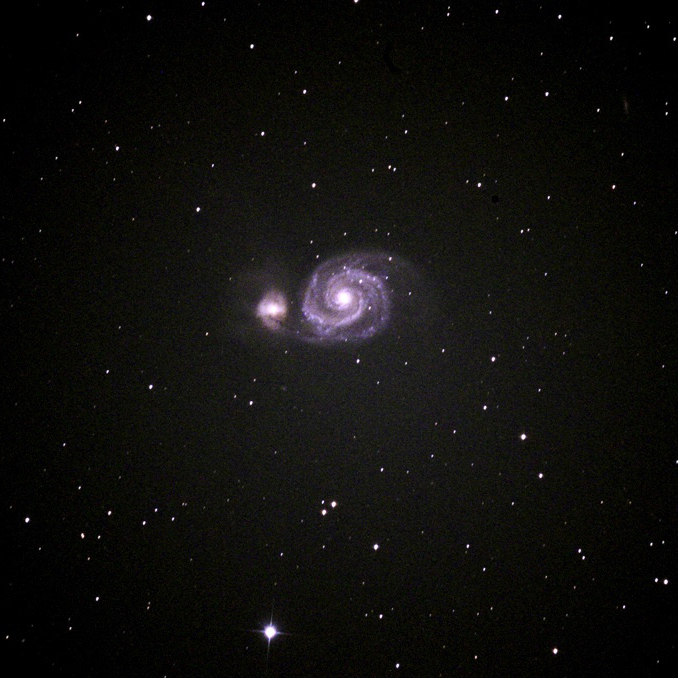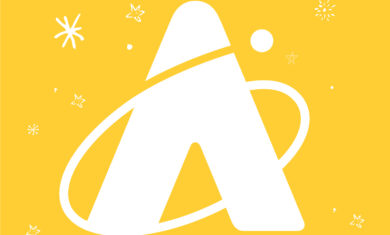You Asked, Our Astronomers Answered!

Header Image: A beautiful image of The Whirlpool Galaxy taken by an Adler Planetarium Telescope Volunteer. Image Credit: Bill Chiu
Our universe is vast, mysterious, and ever expanding! Astronomers are constantly discovering and uncovering new secrets about space, which we know can lead to lots of questions. What is a black hole? When can you see the ISS? How old is the universe really? Well, you asked and our astronomers answered. Here are answers to some of the most frequently asked questions Adler Planetarium astronomers receive.
Is it more likely humans could inhabit Mars or Venus first?
“Mars and Venus would be very different places to live! Venus has a thick atmosphere that traps a lot of heat, so it is over 800 degrees Fahrenheit on its surface, while Mars has a thin atmosphere and is really cold. If you had to pick a planet to live on besides Earth, Mars is your best bet.” – Astronomer Lucianne
How are black holes formed?
“Black holes come in different sizes. The small ones are from collapsed stars a few dozen times as massive as the Sun. The supermassive blackholes, millions or billions of times larger than the small one, well… we don’t know how they form.” – Astronomer Geza
What’s inside a black hole?
“We don’t really know, because once something goes in, it can’t come out! But our best theory right now, Einstein’s Theory of General Relativity, says that inside a black hole space and time get more and more twisted until at the very center they cease to exist. We don’t think this can be quite right, but we don’t yet have a better description.” – Astronomer Geza
Learn more about black holes and the first-ever up close picture taken of one here.
Why is there currently a debate on the age of the universe?
“Measuring how fast the universe is expanding (the Hubble Constant) leads you to the age of the universe. You just track back to when the universe would have zero size. In detail it turns out it is actually a bit more complicated than that, because the rate of the universe’s expansion changes over time. To model that you need to know what the universe is made of (how much dark matter and dark energy it has, for example). We can do that, however, it seems like the different techniques we use to measure the age of the universe give different results. In particular measurements done on the early universe using the cosmic microwave background give an older universe than measurements of the modern universe. Why are they different? There are two main possibilities. First: either one (or both) of the measurements is slightly off, or second: perhaps there is something missing from our theories.” – Astronomer Mark S.
What are moons?
“Moons are things that orbit around planets, dwarf planets, and minor planets (aka, asteroids) rather than around the Sun. They are also called “natural satellites” for this reason.” – Astronomer Mark H.
Can you see the International Space Station at night shining from reflected sunlight?
“Absolutely! The ISS is big and it has many pieces that are highly reflective, like large solar panels. The ISS is best seen either after sunset or before sunrise, depending on the date, and your location. While it may still be dark here on the ground, up at the altitude of the ISS, it will already be sunny or it is still sunny.” – Astronomer Michelle
Read how to spot the ISS here and see if the ISS will be visible for your location.
Why do stars flicker while planets don’t?
“Stars (other than our Sun) are so far away we see them as points of light. Earth’s atmosphere causes those points of light to flicker. Planets look like small disks in a telescope – the atmosphere’s effect isn’t quite the same. On the Moon, stars won’t flicker!” – Astronomer Grace
Learn how to properly identify planets here.
How do light years work? It seems confusing and how accurate is that measurement?
“A light year is the distance light travels in one “Julian” year. Both the speed of light and the Julian year are exactly defined, so one light year is exactly 9460730472580800 meters. The distance to stars and galaxies is another kettle of fish entirely!” – Astronomer Geza
When will Pluto complete its first full revolution around the Sun since its discovery?
“Pluto was discovered in 1930. It takes Pluto 248 years to orbit the Sun, so it will complete its first full revolution around the Sun since its discovery in the year 2178. In the Star Trek universe, Spock’s father Sarek will enter his teens (in Earth years) that year.” – Astronomer Grace
If Betelgeuse goes supernova, will its name change? And how long post supernova will it take for us to actually see it?
“When a star like Betelguese goes supernova most of its material is blown out into a vast glowing cloud of gas. So Betelguese will become “The nebula formerly known as Betelguese”… But there will also be a tiny remnant, a very hot and fast rotating neutron star. It is still the same star, but because it is so different I’m guessing the IAU will give it a new name. We’ll have to see! Surprisingly, the distance to Betelguese isn’t very well known. It is probably between 600 and 700 light years away from Earth, so we’ll see the explosion 600 to 700 years after it really happens. In fact, it might have exploded already and the light simply hasn’t reached us yet!” – Astronomer Geza
What is your favorite mind-blowing space fact?
“The hydrogen in the water you drink, the “H” in H2O, was created in the Big Bang. The oxygen, O, was created inside massive stars that later exploded.” – Astronomer Michelle
How do we know that so much of the universe if made of dark matter and dark energy?
“Dark matter and dark energy could be called “known unknowns” – we can infer their presence by the way they interact with other things in the Universe.” – Astronomer Grace
We love talking space! If you have more questions, ask us on Instagram and Twitter by using the hashtag #AskAdler. You can learn how telescopes work in our latest Astronomy In 3 Minutes episode or submit a question to one of our astronomers directly on the Ask Adler resources page.






